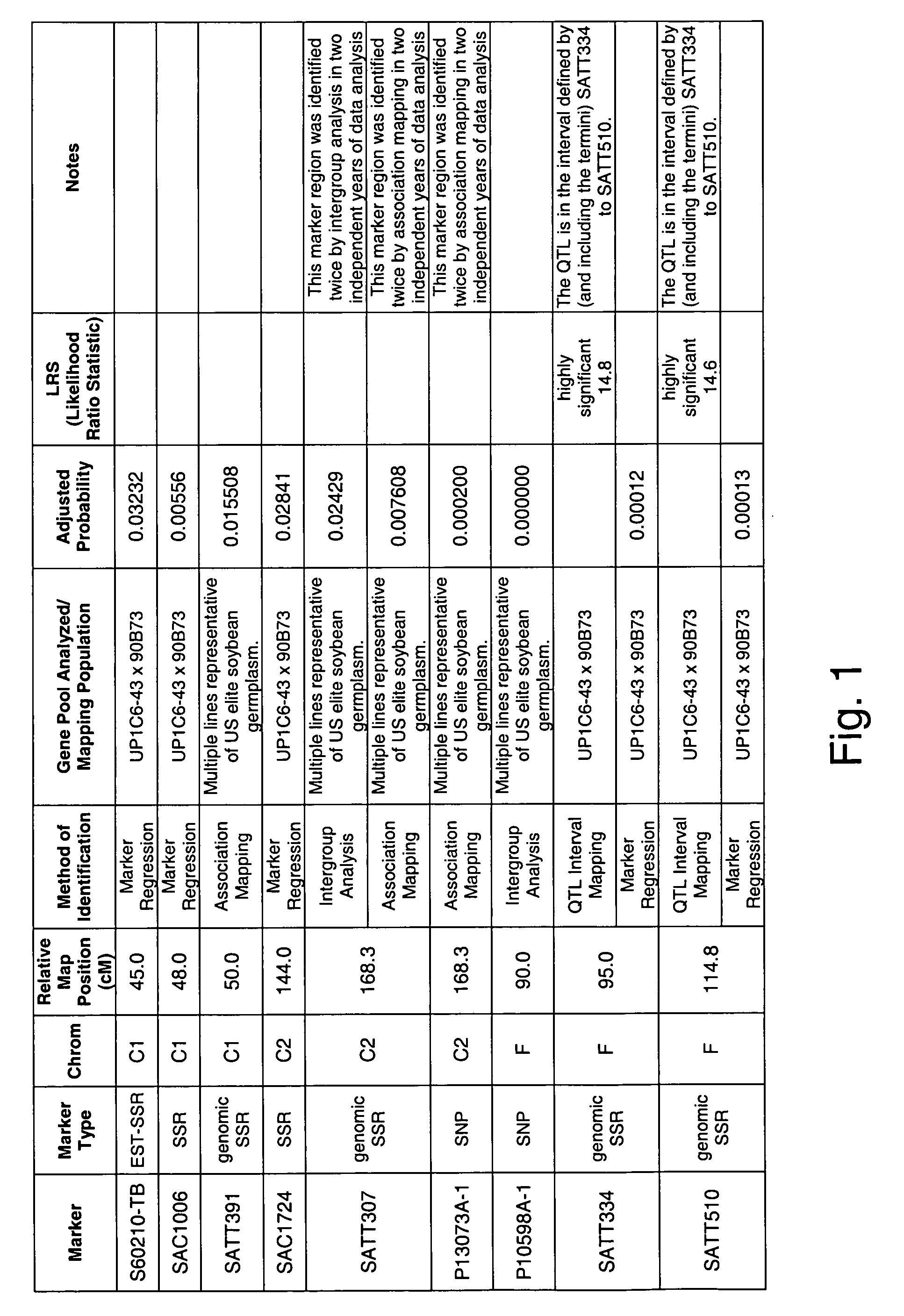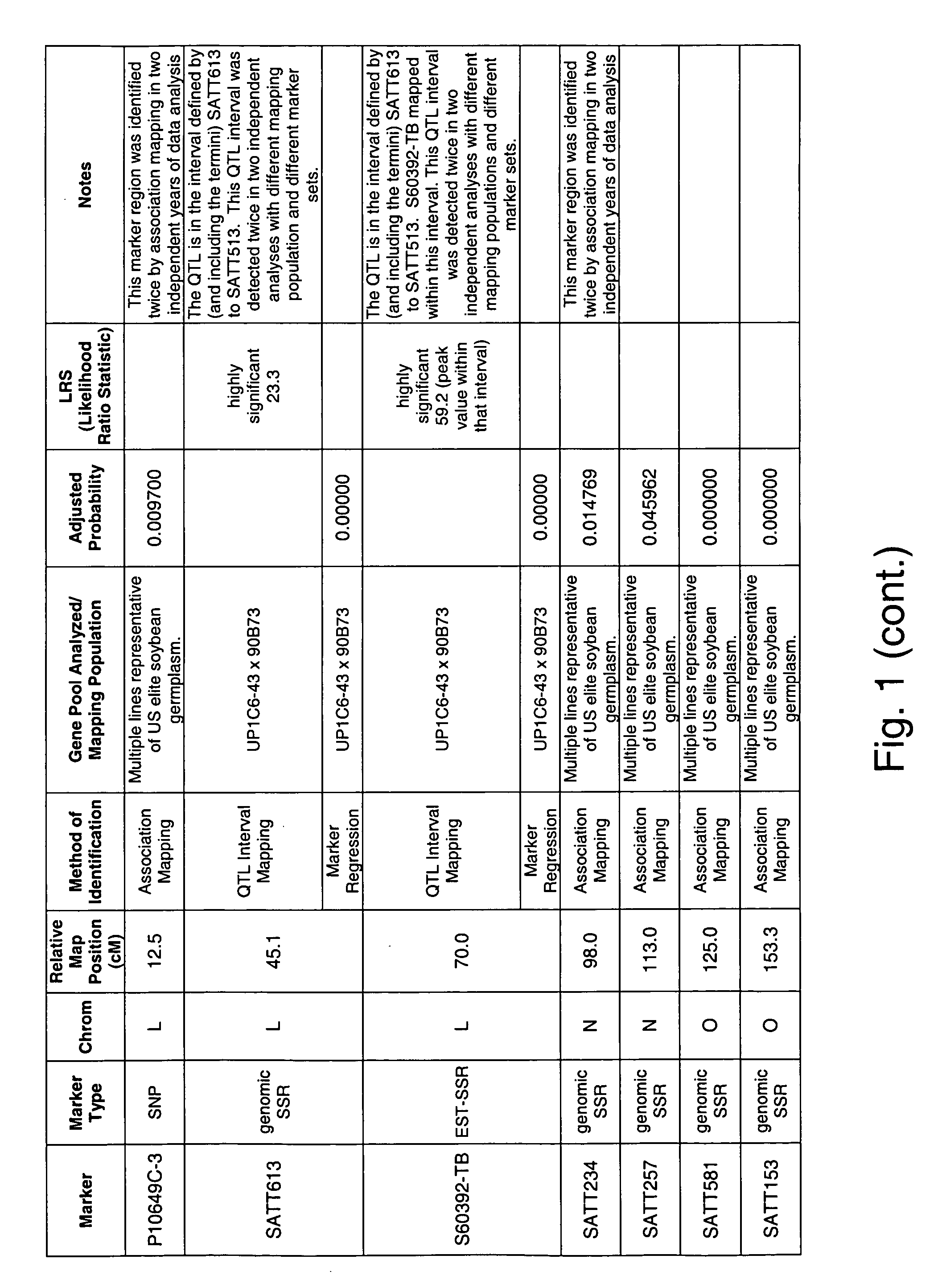Genetic loci associated with iron deficiency tolerance in soybean
a gene locus and soybean technology, applied in the field of gene loci associated with iron deficiency tolerance in soybean, can solve the problems of insoluble form, iron deficiency occurring in soils, unwanted side effects in soybeans or the environment, etc., and achieve the effect of improving tolerance or susceptibility
- Summary
- Abstract
- Description
- Claims
- Application Information
AI Technical Summary
Benefits of technology
Problems solved by technology
Method used
Image
Examples
example 1
Intergroup Allele Frequency Distribution Analysis
[0350] Two independent allele frequency distribution analyses were undertaken to identify soybean genetic marker loci associated with tolerance to low-iron infection. By identifying such genetic markers, marker assisted selection (MAS) can be used to improve the efficiency of breeding for improved tolerance of soybean to iron-deficient growth conditions.
Soybean Lines and Tolerance Scoring
[0351] The plant varieties used in the analysis were from diverse sources, including elite germplasm, commercially released cultivars and other public lines representing a broad range of germplasm. The lines used in the study had a broad maturity range varying from group 0 to group 6.
[0352] Two groups of soybean lines were assembled for each analysis based on their phenotypic extremes in tolerance to iron-deficient growth conditions, where the plants were sorted into either highly susceptible or highly tolerant varieties. The classifications of t...
example 2
Association Mapping Analysis
[0365] An association mapping strategy was undertaken to identify soybean genetic markers associated with tolerance to low iron growth conditions. The study was completed twice, generating two independent data sets. By identifying such genetic markers, marker assisted selection (MAS) can be used to improve the efficiency of breeding for improved tolerance of soybean to low iron growth conditions. Association mapping is known in the art, and is described in various sources, e.g., Jorde (2000), Genome Res., 10:1435-1444; Remington et al. (2001), “Structure of linkage disequilibrium and phenotype associations in the maize genome,” Proc Natl Acad Sci USA 98:11479-11484; and Weiss and Clark (2002), Trends in Genetics 18:19-24.
[0366] Understanding the extent and patterns of linkage disequilibrium (LD) in the genome is a prerequisite for developing efficient association approaches to identify and map quantitative trait loci (QTL). Linkage ...
example 3
QTL Interval Mapping and Single Marker Regression Analysis
[0384] Two independent QTL interval mapping and marker regression analyses were undertaken to identify soybean genetic markers and chromosome intervals associated with tolerance that allow the plant to escape the pathology associated with growth in iron-poor conditions. QTL mapping and marker regression are widely used method to identify genetic loci that co-segregate with a desired phenotype. By identifying such genetic loci, marker assisted selection (MAS) can be used to improve the efficiency of breeding for improved soybean strains.
Study A
[0385] Materials and Methods
[0386] A mapping population for iron-deficiency tolerance was created using the mapping population UP1C6-43 / 90B73. The population had 458 progeny that were used in the mapping.
[0387] Phenotypic scoring took place in replicated plots that were planted in fields known to promote FEC pathology. Planting sites near Cottonwood, Minn. and near Glyndon, Minn. w...
PUM
| Property | Measurement | Unit |
|---|---|---|
| genetic recombination frequency | aaaaa | aaaaa |
| pH | aaaaa | aaaaa |
| temperatures | aaaaa | aaaaa |
Abstract
Description
Claims
Application Information
 Login to View More
Login to View More - R&D
- Intellectual Property
- Life Sciences
- Materials
- Tech Scout
- Unparalleled Data Quality
- Higher Quality Content
- 60% Fewer Hallucinations
Browse by: Latest US Patents, China's latest patents, Technical Efficacy Thesaurus, Application Domain, Technology Topic, Popular Technical Reports.
© 2025 PatSnap. All rights reserved.Legal|Privacy policy|Modern Slavery Act Transparency Statement|Sitemap|About US| Contact US: help@patsnap.com



